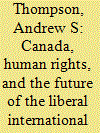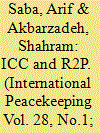|
|
|
Sort Order |
|
|
|
Items / Page
|
|
|
|
|
|
|
| Srl | Item |
| 1 |
ID:
160804


|
|
|
|
|
| Summary/Abstract |
Human rights—specifically international human rights law—have been central to the success of the liberal international order. But since the founding of the United Nations (UN), Canada has had a complicated relationship with international human rights law. This article provides a survey of sixty years of Canadian human rights diplomacy at the UN Commission on Human Rights, from its establishment in 1946 to its dissolution in 2006. During this period, there were moments when Canada did champion new international law, and did so courageously. Yet there were others, such as during negotiations to recognize and codify the rights of Indigenous peoples, when it stood in the way of progress. But the international order that has served Canada so well since the end of the Second World War is under threat, due to a combination of shifts in the global balance of power, and critical challenges such as climate change. If it is to survive into the twenty-first century, advanced democracies such as Canada will need to lead in the development and enforcement of international human rights law, a role that governments in Ottawa have at various times been reluctant to play.
|
|
|
|
|
|
|
|
|
|
|
|
|
|
|
|
| 2 |
ID:
177850


|
|
|
|
|
| Summary/Abstract |
The ICC and R2P share the goal of ending atrocity crimes. Nonetheless, they operate quite differently. Recently, there has been increasing support for bringing the ICC within the R2P toolkits, hoping they will complement each other to achieve their shared goal. The Security Council put this idea into practice to deal with the 2011 crisis in Libya. However, the invocation of ICC against the backdrop of an evolving military intervention under the R2P mandate highlighted significant risks to its integrity and legitimacy. This paper argues that the invocation of ICC to constrain violence and to hold accountable the Libyan regime for atrocity crimes eventually resulted in legitimizing military intervention and regime change under the R2P mandate. The Libya case suggests that neither the push for complementarity nor a full separation between the ICC and R2P benefits the ICC. There needs to be a balance between full engagement and separation. Such an alternative rests on the ICC avoiding entanglement with R2P’s military mandate, while maintaining close interaction with its non-military components through the Security Council. Lastly, the paper also points to areas in which the Council could play a more constructive role in cementing greater cooperation between R2P and the ICC.
|
|
|
|
|
|
|
|
|
|
|
|
|
|
|
|
| 3 |
ID:
146677


|
|
|
|
|
| Summary/Abstract |
Is R2P the most effective tool the international community has to prevent genocide, or the newest neo-imperial norm perpetuated by the most powerful states? In a dramatic performance of the key debates within R2P, each of these views is presented before Aristotlean and Tocquevillean insights are drawn upon to find a middle ground rooted in citizen resistance against mass atrocity crimes. R2P can both become a more effective tool of prevention and gain needed political legitimacy by drawing on the rich historical tradition of citizen resistance to empower local actors defying regimes engaged in mass atrocity crimes.
|
|
|
|
|
|
|
|
|
|
|
|
|
|
|
|
| 4 |
ID:
146673


|
|
|
|
|
| Summary/Abstract |
Far from having faded away, ten years after its formal adoption, the responsibility to protect (R2P), is arguably more relevant than ever. In the current overall context of protection crises, heightened in severity by the emergence of violent extremists, R2P has changed the way in which the international community characterises situations that involve protection failures, and has raised expectations about what should occur when atrocity crimes have been committed or are imminent. UN member states now agree that prevention is at the core of R2P, that international action should employ the full range of diplomatic, political and humanitarian measures, and that military force should only be considered as a measure of last resort. While there is continued contestation about particular aspects of R2P – as there is over much older normative advancements, such as human rights – R2P has helped to forge political consensus and build new institutional capacity to prevent and respond to atrocity crimes.
|
|
|
|
|
|
|
|
|
|
|
|
|
|
|
|
| 5 |
ID:
154698


|
|
|
|
|
| Summary/Abstract |
While global consensus on the meaning and application of the responsibility to protect (R2P) principle remains tenuous, there is little contention among major actors that the development of the norm should prioritise the prevention of mass atrocities. In particular, Brazil, Russia, India, China and South Africa (BRICS) – which have a role to play that is vital to the future development of R2P as a global norm but which continue to express reservations about the intent and application of the doctrine – have been strong advocates of the preventive aspects of the principle. This rhetorical consensus, however, belies the conceptual and practical challenges that are associated with the prevention of mass atrocities. In this paper, the example of South Africa’s post-conflict reconstruction and development (PCRD) interventions in South Sudan from 2005 to 2013 is used to reflect on the role of external actors in supporting conflict-affected states to implement the preventive aspects of R2P. It is argued that while South Africa, like other BRICS countries, has used the rhetoric that atrocity prevention should be at the core of R2P to legitimise its opposition to military intervention for humanitarian purposes, it has struggled to back this rhetoric with coherent strategies and concrete actions to prevent mass atrocity crimes within its sphere of influence. The gap between rhetoric and practice in the preventive aspects of R2P is not unique to South Africa, but highlights fundamental difficulties inherent to global efforts to prevent mass atrocities.
|
|
|
|
|
|
|
|
|
|
|
|
|
|
|
|
|
|
|
|
|